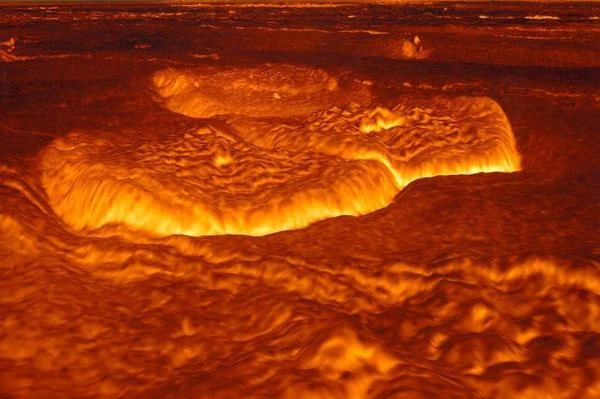
Venus, often referred to as Earth's twin sister, has a comparable size and mass. However, its environment is radically different. The average temperature on its surface reaches 470°C, enough to melt lead. Its atmosphere, composed of 96.5% carbon dioxide, exerts a pressure 92 times higher than that of Earth at sea level. The permanent cloud cover, rich in sulfuric acid, blocks optical radiation and acts as a thermal greenhouse of formidable efficiency.
This contrast raises a major question in planetology: why did two planets so similar in appearance evolve into such opposite climates? The greenhouse effect on Venus is not just a climatic effect, but a process of positive feedback initiated billions of years ago, which led to irreversible thermal instability. Climate simulations indicate that liquid water may have briefly existed on the surface of Venus before the intensity of solar radiation led to its evaporation, triggering a runaway greenhouse effect.

The atmosphere of Venus, composed mainly of carbon dioxide with clouds of sulfuric acid, is one of the densest and most inhospitable in the solar system. This thick cover creates an extreme greenhouse effect, making Venus the hottest planet in our system, with surface temperatures exceeding 450°C. Despite these infernal conditions, scientists seek to uncover the secrets of this opaque atmosphere, which could reveal clues about the climatic evolution of planets, including that of Earth.
Beneath this impenetrable cloud layer, invisible in the Magellan image, Venus jealously guards its secrets. Recently, the detection of phosphine in its atmosphere has reignited debates about possible unknown biological or geochemical activity. Phosphine is a chemical compound with the formula PH3. It is a colorless, flammable, and highly toxic gas, with an unpleasant odor often compared to that of garlic or rotten fish.
Despite an extremely slow rotation (a Venusian day lasts 243 Earth days) and in the retrograde direction, its high-altitude winds reach up to 360 km/h. This phenomenon of atmospheric super-rotation remains an active subject of study. The mechanisms of energy transfer between the lower atmosphere and the upper mesosphere, as well as the effect of thermal tides due to the Sun, could play a central role.
Moreover, the absence of a global magnetic field accentuates atmospheric erosion by the solar wind, although paradoxically, Venus retains a dense atmosphere. This suggests continuous internal contributions, possibly of volcanic origin. Indeed, several surface structures identified by radar resemble calderas and recent basalt flows. The question of current volcanic activity is revived by infrared emissivity data obtained by the Venus Express probe.
The surface of Venus is now sterile due to its extreme conditions: temperatures above 450°C, crushing pressure, and toxic atmosphere. However, the hypothesis of microbial life in the Venusian atmosphere has been seriously considered, particularly in the cloud layers located between 48 and 60 km in altitude. At these altitudes, the temperature ranges from 30°C to 80°C and the pressure is close to 1 atm, conditions relatively similar to those on Earth.
Interest in this so-called "habitable" atmospheric zone was revived in 2020 by the controversial detection of phosphine (PH₃), a molecule associated on Earth with anaerobic biological processes. Although the detection remains subject to caution, it has opened a fundamental debate: could life forms survive in such an acidic and water-poor environment?
The clouds of Venus are mainly composed of droplets of concentrated sulfuric acid \((\sim 75 \text{ to } 98\%)\) mixed with small amounts of water. Such an environment is extremely corrosive to carbon-based cellular structures, such as lipid membranes. However, some terrestrial extremophile bacteria, notably acidophiles and halophiles, have shown an astonishing ability to survive in very acidic (pH < 1) or nutrient-poor environments, fueling speculation.
Alternative biochemical models have been proposed for cells using non-lipid membranes (based on sulfur polymers, for example), as well as metabolic cycles exploiting sulfur dioxide \((\mathrm{SO_2})\), sulfuric acid, and atmospheric carbon. In these hypotheses, the cells would be suspended in the cloud layers and maintained in dynamic equilibrium by convection and rapid zonal winds.
However, several major challenges remain: the low water content (less than 0.01%), the intensity of ultraviolet radiation in the upper atmosphere, the lack of available nutrients, and above all, the transient nature of the stability of the droplets where life could potentially develop. Furthermore, modeling the chemical evolution of the clouds shows that they are globally oxidizing and destructive to complex organic compounds.
The Indian Space Research Agency (ISRO), NASA, and ESA are planning future missions to Venus (Shukrayaan-1, VERITAS, EnVision) that could clarify these points. Some of these missions will carry spectrometers capable of detecting molecular biosignatures, or even complex biological particles. The discovery of an aerial biosphere on Venus would revolutionize our understanding of life in the universe, demonstrating that it can appear and persist in environments radically different from Earth.